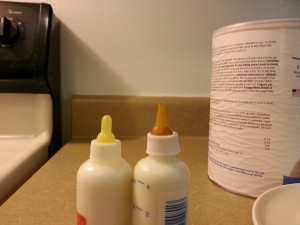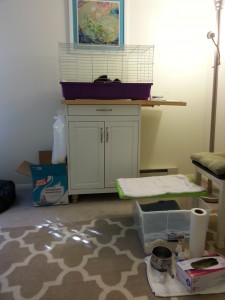 Bottle feeding is a lifesaving intervention, one which requires time, dedication and patience. There is a plethora of resources available on the subject, and I personally recommend the Maddie’s Institute webinars from 2013. You can read many fact sheets about how big the kitten should be, the volume of their stomachs, the correct ambient temperature, etc. True, there are a lot of technicalities when rearing kittens, but what I’d like to share with you today are some pearls of wisdom about the daily grind of feeding kittens.
Bottle feeding is a lifesaving intervention, one which requires time, dedication and patience. There is a plethora of resources available on the subject, and I personally recommend the Maddie’s Institute webinars from 2013. You can read many fact sheets about how big the kitten should be, the volume of their stomachs, the correct ambient temperature, etc. True, there are a lot of technicalities when rearing kittens, but what I’d like to share with you today are some pearls of wisdom about the daily grind of feeding kittens.

Tip 1: Scheduling. Very young kittens need to be fed every 2-3 hours, with larger ones being able to handle up to 8 hour stretches. You will get a sense for your kittens’ schedule based on how much they eat at each feeding and how active they are between feedings. If you find that they aren’t eating much in one session, then consider waiting an extra hour between feedings to see if that will increase their appetite. Make sure you can accommodate the feedings in your daily schedule. I recommend staying up late, with a last feeding at 10-11pm, and waking up once at 2-3am, then doing a morning feed at 6-7am. Do what feeds right for your schedule and remember to get some shut eye!
Tip #2: Mixing KMR. While it is best to mix up your KMR or milk replacement as fresh as possible, this is a great way to shave off time. I mix my milk once or twice a day in a large batch, then I just refill bottles as needed. I thoroughly wash and dry all my bottles once a day. When mixing up the KMR, add your powder to a large mason jar, cup or bowl. Slowly add water while mixing with a spoon to form a paste. This makes it much less lumpy than adding the powder to the water. In order to get perfect KMR I strain it in a fine mesh sieve several times to remove all lumps. Pre-fill all your bottles so that you are ready to go at 3 and 6 am (in my case that’s 4 full bottles). Invest in a small funnel to fill your bottles without any drips!

Tip #3: Nipples. The perfect KMR will be rejected by a kitten if your bottle’s nipple is the wrong shape, size or diameter. There are many products available on the market, and it takes some trial and error to get it just right. The best nipples are short and rounded, such as this one from PetAg or this one from Hartz. I don’t like the long, taper, triangular ones such as this one from Four Paws. That being said, the opening itself is more important than the shape of the nipple. The goal of cutting the “X” in the nipple is to make sucking easy so that you aren’t tempted to squeeze the bottle. You are better off making a hole too big, rather than too small. When turned upside down the bottle should steadily drip, and when smashed into a kitten’s face it should make a mess. The messier the nipple the more likely the kitten is to latch on, that little drip at the end is great for encouragement.
Tip #4: Cleaning, feeding, cleaning. Every kitten must be stimulated to go the bathroom before feeding, which inevitable makes a mess. There are several ways to do this. You can use a wet cloth or paper towel to stimulate them, or if you are budget like me then just use your gloved fingers. I hold the kitten over a towel, let them go, and then clean up their rears with a paper towel. If they are having diarrhea then I will use a paper towel, as I don’t want this to drip onto my towel (regular feces I can spot clean afterwards). This allows me to quickly do numerous kittens and reuse the one towel. After feeding kittens are inevitably dirty again, use a wet paper towel or rag to clean their faces and paws. This is very important because the milk will cause awful mats and crusts in their fur. Even worse their litter mates may try to suckle on the dirty kitten, which can lead to serious trauma and even death if unchecked. A clean kitten is a happy kitten–never let your kittens get dirty!

Tip #5 High volume set ups. Create a space for yourself to maximize efficiency in kitten feeding, as you will save a lot of time if you can keep an area set up for your kittens! I use a three tiered approach, as seen in the picture, I have a station for cleaning, for feeding, and then the primary enclosure. Kittens are moved from the primary enclosure and placed in the large floor Tupperware and are pottied. This catches all their mess and holds kittens waiting to be fed. The kitten to be fed is then placed on the Tupperware lid, and is then moved back up to the main cage. The lid I keep on my left, so that once the feeding kitten is latched on, I can hold that bottle with my left hand. I can use my more dexterous hand to use a second bottle to feed an eager kitten inside the Tupperware simultaneously.
Note that all my supplies are on my right (I am right handed), and I have trash and spare everything within reach. I prefer to feed sitting on the ground so that I can utilize maximum floor space. I use a bowl of hot water to warm my KMR straight from the fridge, and by the time I am done feeding it is the perfect temperature to clean kittens with.
Using this set up I can do seven kittens in under 30 minutes, what time-saving tips have you picked up over the years? Please share below in the comments section!


One thought on “Diary of a bottle feeder”